Taxation Law: An Overview of R&D Tax Incentives in Australia
VerifiedAdded on 2021/06/14
|11
|2737
|54
Report
AI Summary
This report provides an overview of Australian taxation law related to research and development (R&D) tax incentives. It begins with an introduction to the topic, highlighting the substantial subsidies provided for innovation and the introduction of the R&D tax incentive system in Australia. The report then explores the regulatory framework, including the Income Tax Assessment Act 1997 (ITAA 1997) and the objectives of the R&D tax concessions. It discusses the eligibility criteria for small businesses, the effectiveness of the incentives, and the impact of tax reforms. The report also examines the future direction of R&D tax incentives, including changes to refundable and non-refundable tax offsets and the introduction of a research and development premium. Finally, it concludes by emphasizing the importance of these incentives for the competitiveness and investment in Australian businesses. The report covers key aspects such as the 150% tax deduction, the role of approved research institutes, and the impact of government budgets on R&D tax incentives.
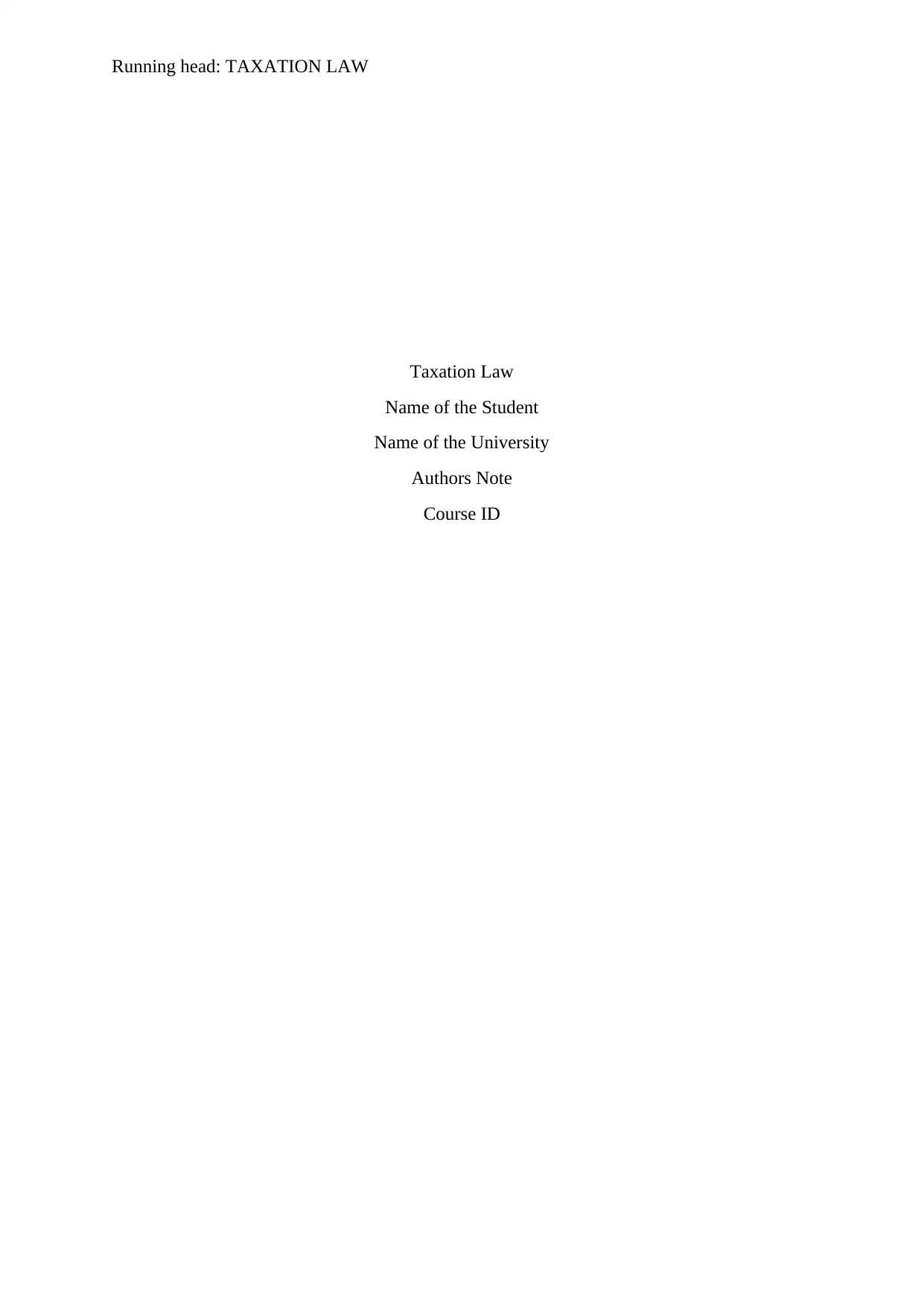
Running head: TAXATION LAW
Taxation Law
Name of the Student
Name of the University
Authors Note
Course ID
Taxation Law
Name of the Student
Name of the University
Authors Note
Course ID
Paraphrase This Document
Need a fresh take? Get an instant paraphrase of this document with our AI Paraphraser
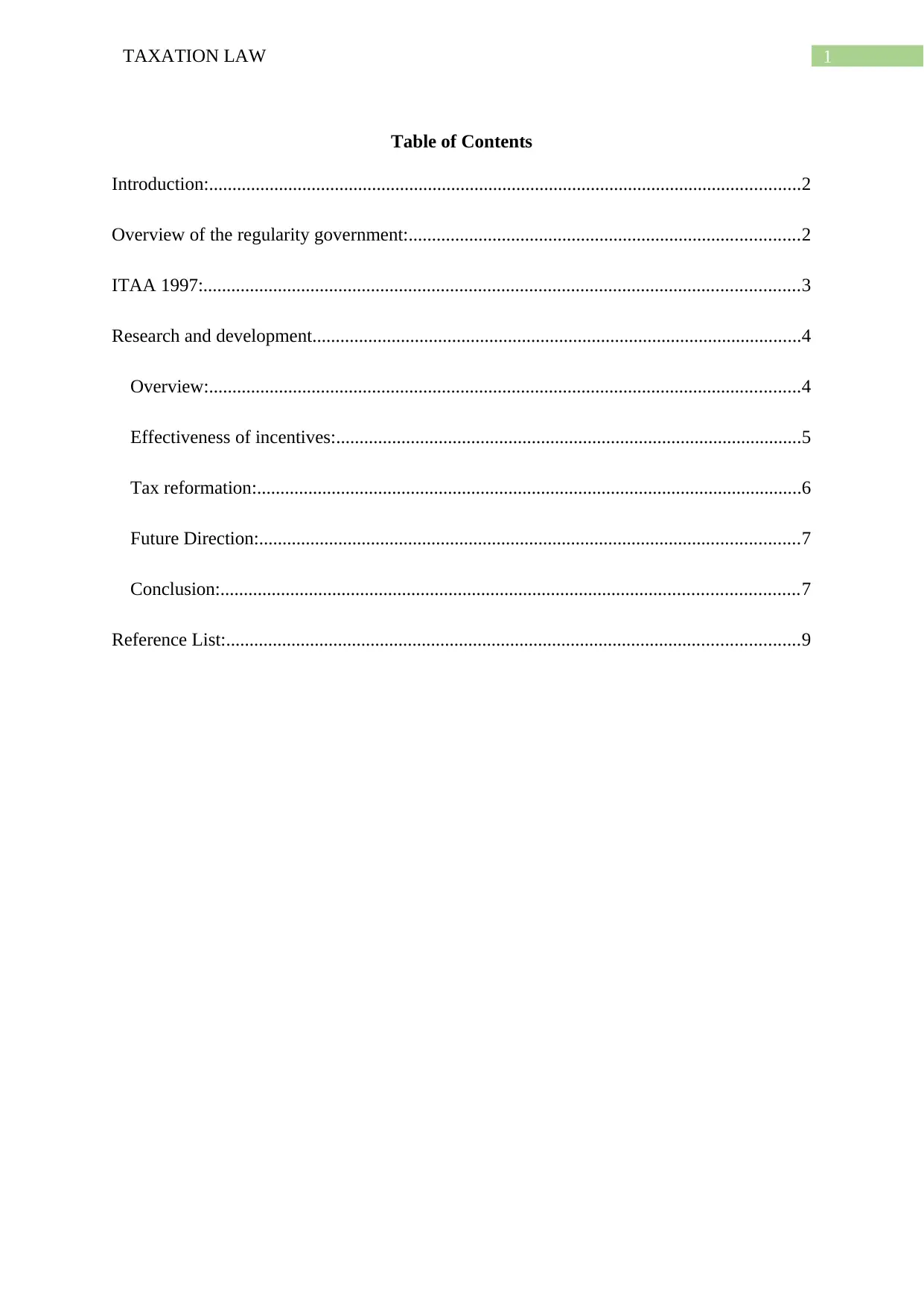
1TAXATION LAW
Table of Contents
Introduction:...............................................................................................................................2
Overview of the regularity government:....................................................................................2
ITAA 1997:................................................................................................................................3
Research and development.........................................................................................................4
Overview:...............................................................................................................................4
Effectiveness of incentives:....................................................................................................5
Tax reformation:.....................................................................................................................6
Future Direction:....................................................................................................................7
Conclusion:............................................................................................................................7
Reference List:...........................................................................................................................9
Table of Contents
Introduction:...............................................................................................................................2
Overview of the regularity government:....................................................................................2
ITAA 1997:................................................................................................................................3
Research and development.........................................................................................................4
Overview:...............................................................................................................................4
Effectiveness of incentives:....................................................................................................5
Tax reformation:.....................................................................................................................6
Future Direction:....................................................................................................................7
Conclusion:............................................................................................................................7
Reference List:...........................................................................................................................9
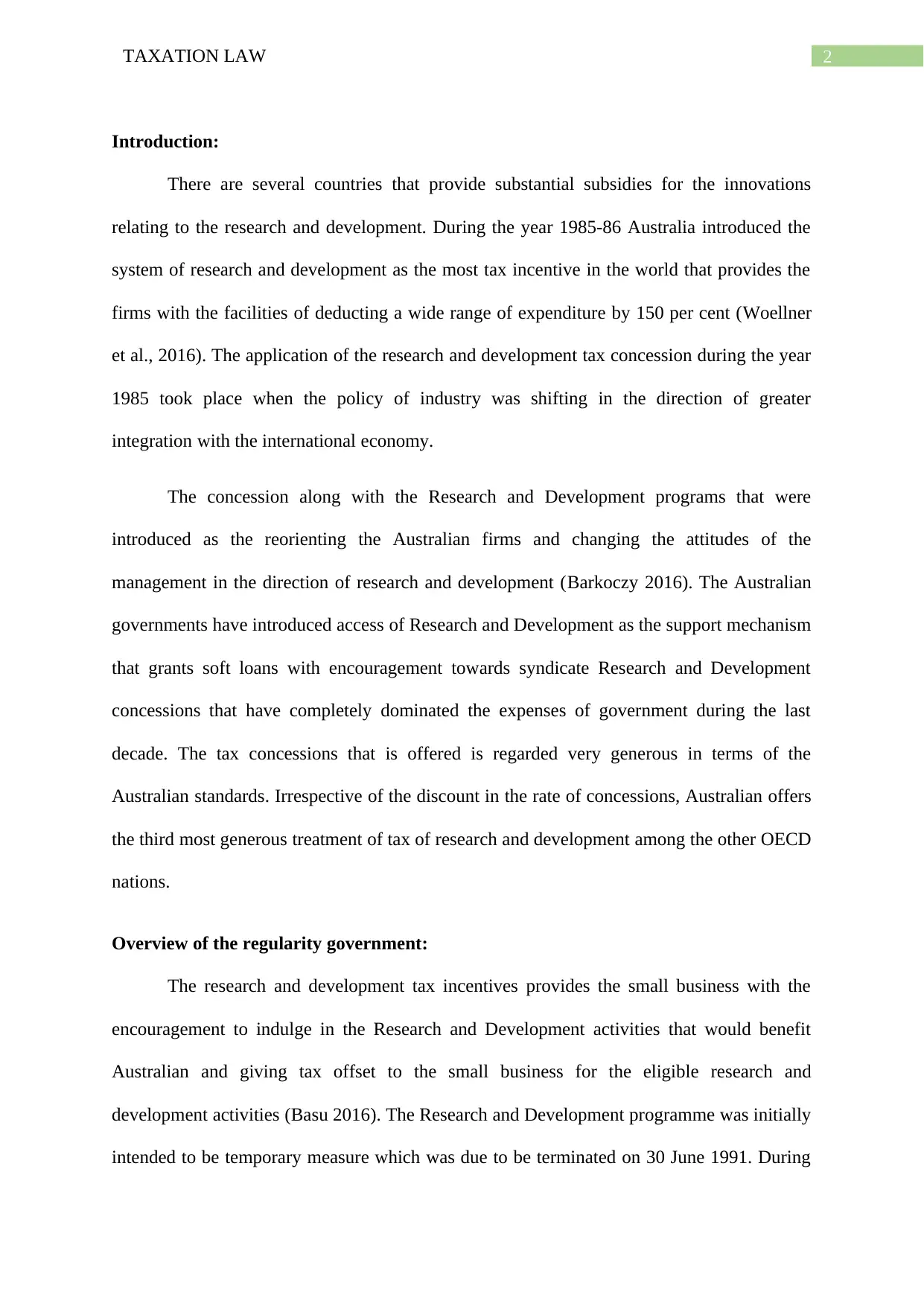
2TAXATION LAW
Introduction:
There are several countries that provide substantial subsidies for the innovations
relating to the research and development. During the year 1985-86 Australia introduced the
system of research and development as the most tax incentive in the world that provides the
firms with the facilities of deducting a wide range of expenditure by 150 per cent (Woellner
et al., 2016). The application of the research and development tax concession during the year
1985 took place when the policy of industry was shifting in the direction of greater
integration with the international economy.
The concession along with the Research and Development programs that were
introduced as the reorienting the Australian firms and changing the attitudes of the
management in the direction of research and development (Barkoczy 2016). The Australian
governments have introduced access of Research and Development as the support mechanism
that grants soft loans with encouragement towards syndicate Research and Development
concessions that have completely dominated the expenses of government during the last
decade. The tax concessions that is offered is regarded very generous in terms of the
Australian standards. Irrespective of the discount in the rate of concessions, Australian offers
the third most generous treatment of tax of research and development among the other OECD
nations.
Overview of the regularity government:
The research and development tax incentives provides the small business with the
encouragement to indulge in the Research and Development activities that would benefit
Australian and giving tax offset to the small business for the eligible research and
development activities (Basu 2016). The Research and Development programme was initially
intended to be temporary measure which was due to be terminated on 30 June 1991. During
Introduction:
There are several countries that provide substantial subsidies for the innovations
relating to the research and development. During the year 1985-86 Australia introduced the
system of research and development as the most tax incentive in the world that provides the
firms with the facilities of deducting a wide range of expenditure by 150 per cent (Woellner
et al., 2016). The application of the research and development tax concession during the year
1985 took place when the policy of industry was shifting in the direction of greater
integration with the international economy.
The concession along with the Research and Development programs that were
introduced as the reorienting the Australian firms and changing the attitudes of the
management in the direction of research and development (Barkoczy 2016). The Australian
governments have introduced access of Research and Development as the support mechanism
that grants soft loans with encouragement towards syndicate Research and Development
concessions that have completely dominated the expenses of government during the last
decade. The tax concessions that is offered is regarded very generous in terms of the
Australian standards. Irrespective of the discount in the rate of concessions, Australian offers
the third most generous treatment of tax of research and development among the other OECD
nations.
Overview of the regularity government:
The research and development tax incentives provides the small business with the
encouragement to indulge in the Research and Development activities that would benefit
Australian and giving tax offset to the small business for the eligible research and
development activities (Basu 2016). The Research and Development programme was initially
intended to be temporary measure which was due to be terminated on 30 June 1991. During
⊘ This is a preview!⊘
Do you want full access?
Subscribe today to unlock all pages.

Trusted by 1+ million students worldwide
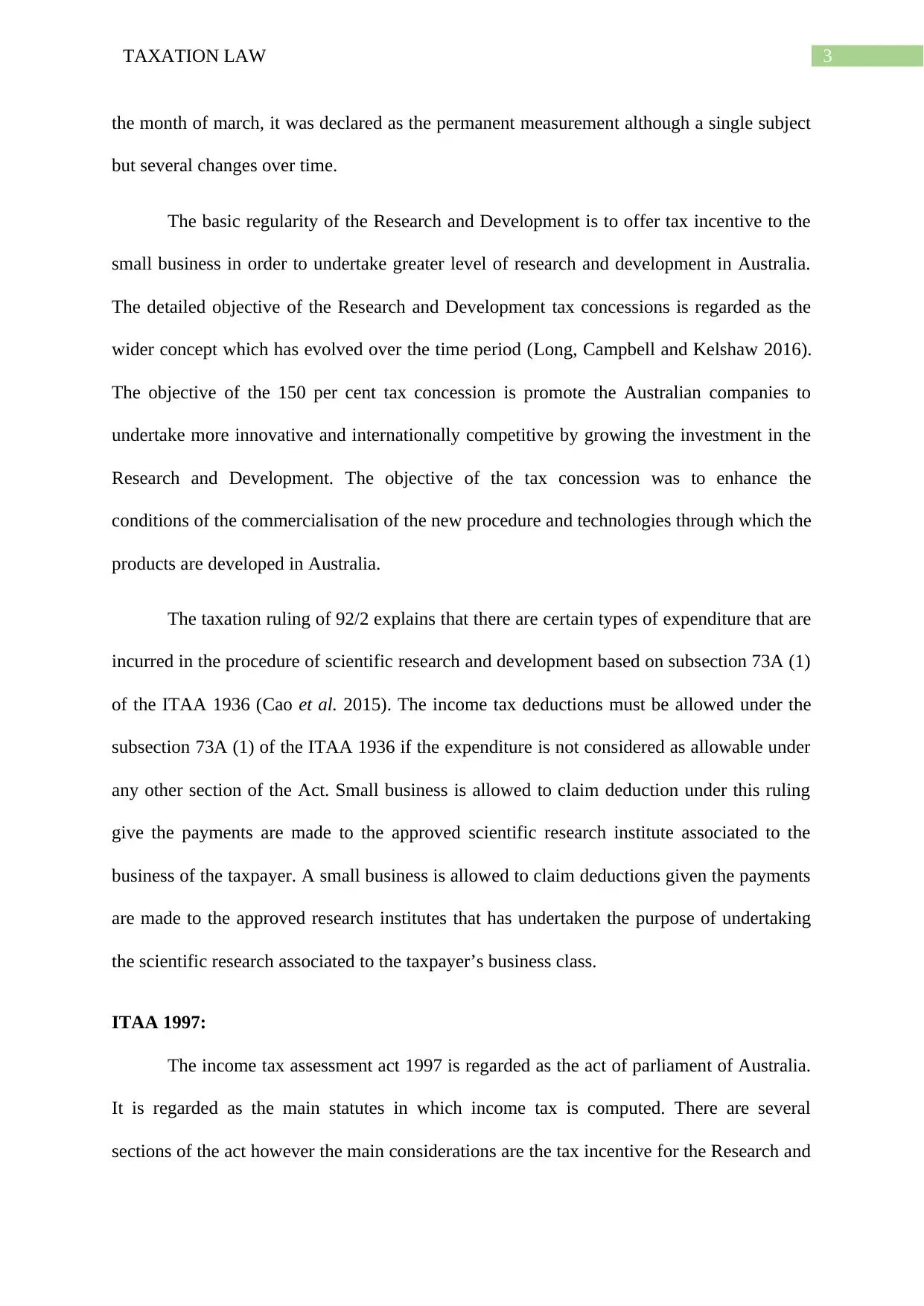
3TAXATION LAW
the month of march, it was declared as the permanent measurement although a single subject
but several changes over time.
The basic regularity of the Research and Development is to offer tax incentive to the
small business in order to undertake greater level of research and development in Australia.
The detailed objective of the Research and Development tax concessions is regarded as the
wider concept which has evolved over the time period (Long, Campbell and Kelshaw 2016).
The objective of the 150 per cent tax concession is promote the Australian companies to
undertake more innovative and internationally competitive by growing the investment in the
Research and Development. The objective of the tax concession was to enhance the
conditions of the commercialisation of the new procedure and technologies through which the
products are developed in Australia.
The taxation ruling of 92/2 explains that there are certain types of expenditure that are
incurred in the procedure of scientific research and development based on subsection 73A (1)
of the ITAA 1936 (Cao et al. 2015). The income tax deductions must be allowed under the
subsection 73A (1) of the ITAA 1936 if the expenditure is not considered as allowable under
any other section of the Act. Small business is allowed to claim deduction under this ruling
give the payments are made to the approved scientific research institute associated to the
business of the taxpayer. A small business is allowed to claim deductions given the payments
are made to the approved research institutes that has undertaken the purpose of undertaking
the scientific research associated to the taxpayer’s business class.
ITAA 1997:
The income tax assessment act 1997 is regarded as the act of parliament of Australia.
It is regarded as the main statutes in which income tax is computed. There are several
sections of the act however the main considerations are the tax incentive for the Research and
the month of march, it was declared as the permanent measurement although a single subject
but several changes over time.
The basic regularity of the Research and Development is to offer tax incentive to the
small business in order to undertake greater level of research and development in Australia.
The detailed objective of the Research and Development tax concessions is regarded as the
wider concept which has evolved over the time period (Long, Campbell and Kelshaw 2016).
The objective of the 150 per cent tax concession is promote the Australian companies to
undertake more innovative and internationally competitive by growing the investment in the
Research and Development. The objective of the tax concession was to enhance the
conditions of the commercialisation of the new procedure and technologies through which the
products are developed in Australia.
The taxation ruling of 92/2 explains that there are certain types of expenditure that are
incurred in the procedure of scientific research and development based on subsection 73A (1)
of the ITAA 1936 (Cao et al. 2015). The income tax deductions must be allowed under the
subsection 73A (1) of the ITAA 1936 if the expenditure is not considered as allowable under
any other section of the Act. Small business is allowed to claim deduction under this ruling
give the payments are made to the approved scientific research institute associated to the
business of the taxpayer. A small business is allowed to claim deductions given the payments
are made to the approved research institutes that has undertaken the purpose of undertaking
the scientific research associated to the taxpayer’s business class.
ITAA 1997:
The income tax assessment act 1997 is regarded as the act of parliament of Australia.
It is regarded as the main statutes in which income tax is computed. There are several
sections of the act however the main considerations are the tax incentive for the Research and
Paraphrase This Document
Need a fresh take? Get an instant paraphrase of this document with our AI Paraphraser
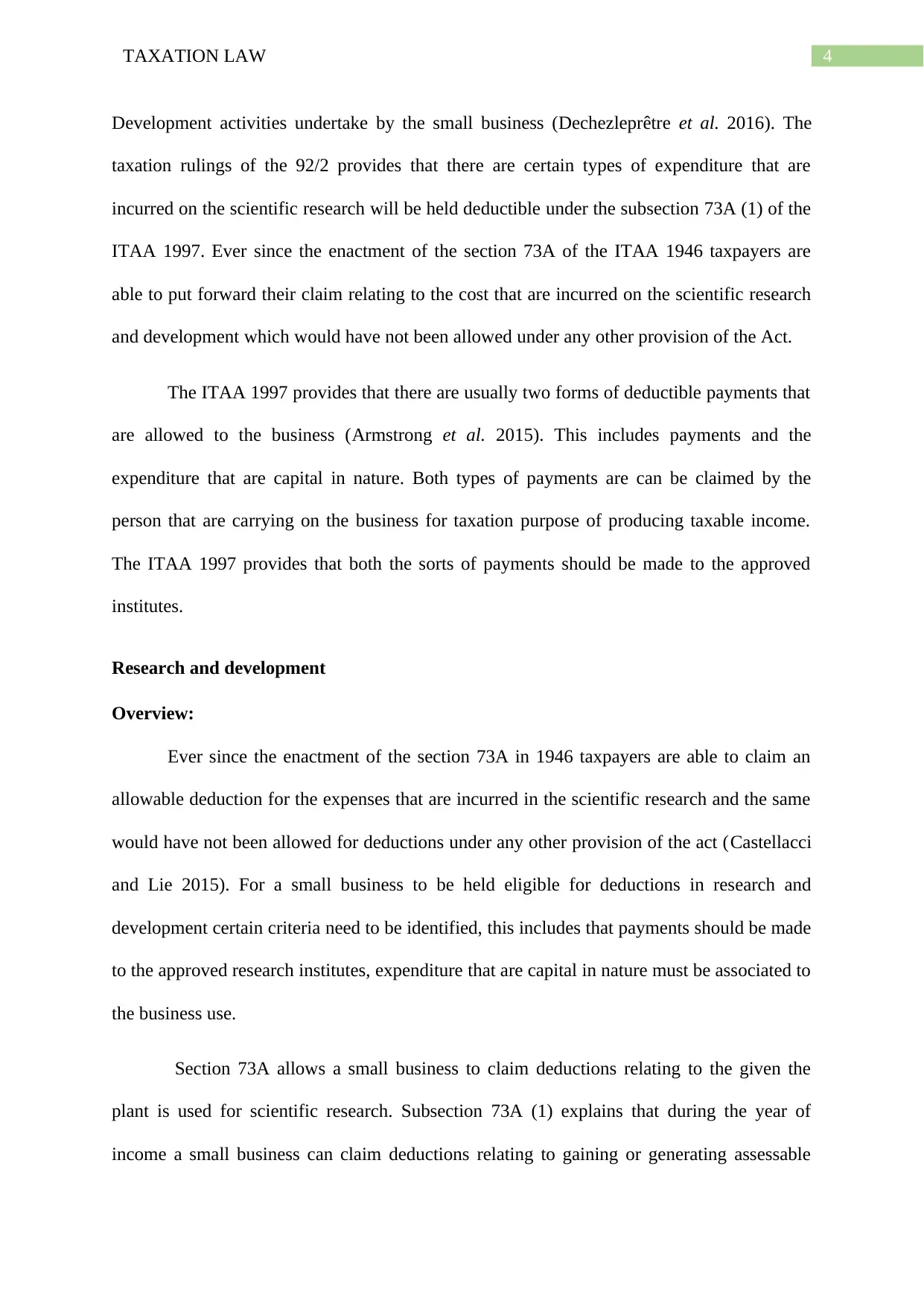
4TAXATION LAW
Development activities undertake by the small business (Dechezleprêtre et al. 2016). The
taxation rulings of the 92/2 provides that there are certain types of expenditure that are
incurred on the scientific research will be held deductible under the subsection 73A (1) of the
ITAA 1997. Ever since the enactment of the section 73A of the ITAA 1946 taxpayers are
able to put forward their claim relating to the cost that are incurred on the scientific research
and development which would have not been allowed under any other provision of the Act.
The ITAA 1997 provides that there are usually two forms of deductible payments that
are allowed to the business (Armstrong et al. 2015). This includes payments and the
expenditure that are capital in nature. Both types of payments are can be claimed by the
person that are carrying on the business for taxation purpose of producing taxable income.
The ITAA 1997 provides that both the sorts of payments should be made to the approved
institutes.
Research and development
Overview:
Ever since the enactment of the section 73A in 1946 taxpayers are able to claim an
allowable deduction for the expenses that are incurred in the scientific research and the same
would have not been allowed for deductions under any other provision of the act (Castellacci
and Lie 2015). For a small business to be held eligible for deductions in research and
development certain criteria need to be identified, this includes that payments should be made
to the approved research institutes, expenditure that are capital in nature must be associated to
the business use.
Section 73A allows a small business to claim deductions relating to the given the
plant is used for scientific research. Subsection 73A (1) explains that during the year of
income a small business can claim deductions relating to gaining or generating assessable
Development activities undertake by the small business (Dechezleprêtre et al. 2016). The
taxation rulings of the 92/2 provides that there are certain types of expenditure that are
incurred on the scientific research will be held deductible under the subsection 73A (1) of the
ITAA 1997. Ever since the enactment of the section 73A of the ITAA 1946 taxpayers are
able to put forward their claim relating to the cost that are incurred on the scientific research
and development which would have not been allowed under any other provision of the Act.
The ITAA 1997 provides that there are usually two forms of deductible payments that
are allowed to the business (Armstrong et al. 2015). This includes payments and the
expenditure that are capital in nature. Both types of payments are can be claimed by the
person that are carrying on the business for taxation purpose of producing taxable income.
The ITAA 1997 provides that both the sorts of payments should be made to the approved
institutes.
Research and development
Overview:
Ever since the enactment of the section 73A in 1946 taxpayers are able to claim an
allowable deduction for the expenses that are incurred in the scientific research and the same
would have not been allowed for deductions under any other provision of the act (Castellacci
and Lie 2015). For a small business to be held eligible for deductions in research and
development certain criteria need to be identified, this includes that payments should be made
to the approved research institutes, expenditure that are capital in nature must be associated to
the business use.
Section 73A allows a small business to claim deductions relating to the given the
plant is used for scientific research. Subsection 73A (1) explains that during the year of
income a small business can claim deductions relating to gaining or generating assessable
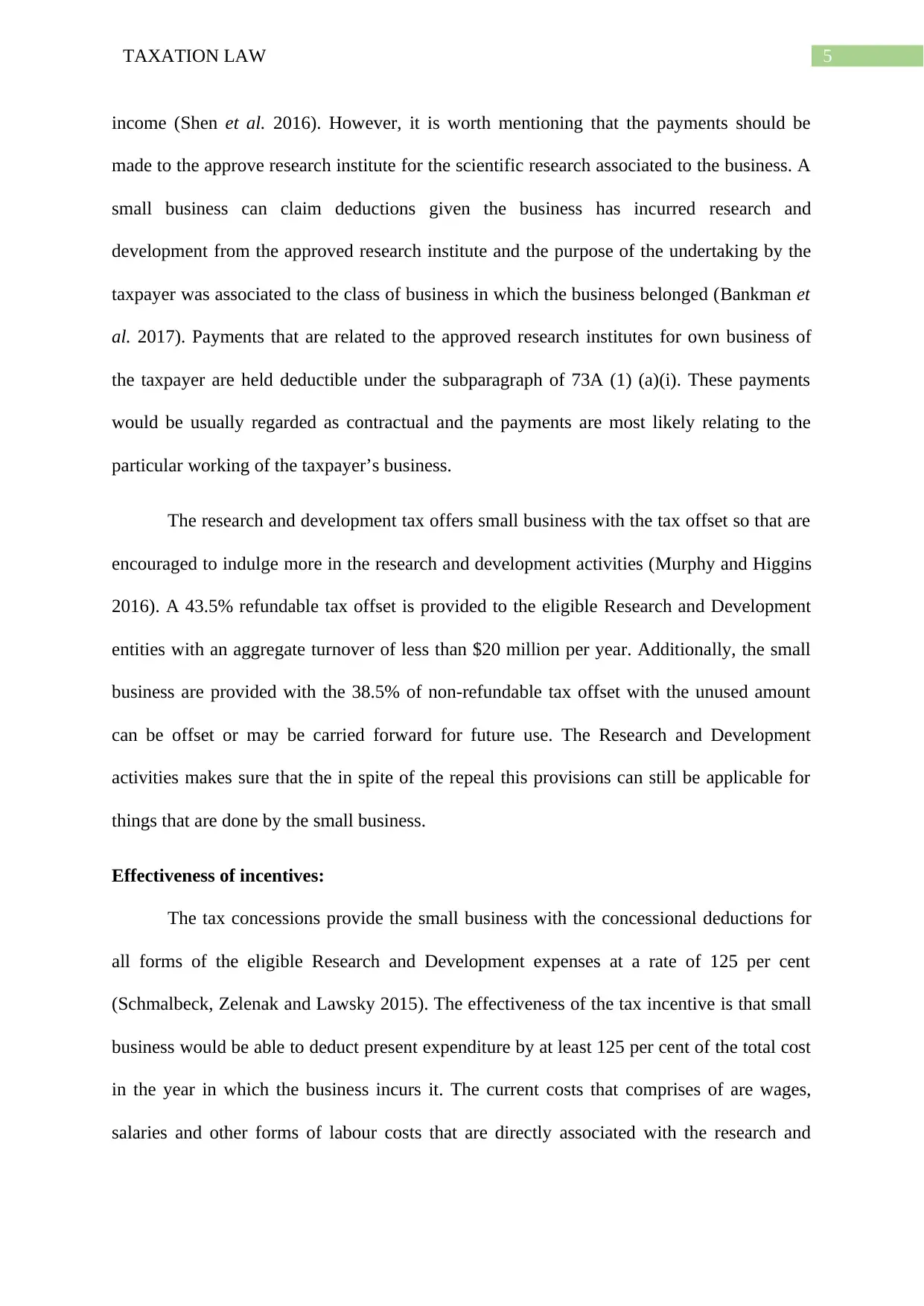
5TAXATION LAW
income (Shen et al. 2016). However, it is worth mentioning that the payments should be
made to the approve research institute for the scientific research associated to the business. A
small business can claim deductions given the business has incurred research and
development from the approved research institute and the purpose of the undertaking by the
taxpayer was associated to the class of business in which the business belonged (Bankman et
al. 2017). Payments that are related to the approved research institutes for own business of
the taxpayer are held deductible under the subparagraph of 73A (1) (a)(i). These payments
would be usually regarded as contractual and the payments are most likely relating to the
particular working of the taxpayer’s business.
The research and development tax offers small business with the tax offset so that are
encouraged to indulge more in the research and development activities (Murphy and Higgins
2016). A 43.5% refundable tax offset is provided to the eligible Research and Development
entities with an aggregate turnover of less than $20 million per year. Additionally, the small
business are provided with the 38.5% of non-refundable tax offset with the unused amount
can be offset or may be carried forward for future use. The Research and Development
activities makes sure that the in spite of the repeal this provisions can still be applicable for
things that are done by the small business.
Effectiveness of incentives:
The tax concessions provide the small business with the concessional deductions for
all forms of the eligible Research and Development expenses at a rate of 125 per cent
(Schmalbeck, Zelenak and Lawsky 2015). The effectiveness of the tax incentive is that small
business would be able to deduct present expenditure by at least 125 per cent of the total cost
in the year in which the business incurs it. The current costs that comprises of are wages,
salaries and other forms of labour costs that are directly associated with the research and
income (Shen et al. 2016). However, it is worth mentioning that the payments should be
made to the approve research institute for the scientific research associated to the business. A
small business can claim deductions given the business has incurred research and
development from the approved research institute and the purpose of the undertaking by the
taxpayer was associated to the class of business in which the business belonged (Bankman et
al. 2017). Payments that are related to the approved research institutes for own business of
the taxpayer are held deductible under the subparagraph of 73A (1) (a)(i). These payments
would be usually regarded as contractual and the payments are most likely relating to the
particular working of the taxpayer’s business.
The research and development tax offers small business with the tax offset so that are
encouraged to indulge more in the research and development activities (Murphy and Higgins
2016). A 43.5% refundable tax offset is provided to the eligible Research and Development
entities with an aggregate turnover of less than $20 million per year. Additionally, the small
business are provided with the 38.5% of non-refundable tax offset with the unused amount
can be offset or may be carried forward for future use. The Research and Development
activities makes sure that the in spite of the repeal this provisions can still be applicable for
things that are done by the small business.
Effectiveness of incentives:
The tax concessions provide the small business with the concessional deductions for
all forms of the eligible Research and Development expenses at a rate of 125 per cent
(Schmalbeck, Zelenak and Lawsky 2015). The effectiveness of the tax incentive is that small
business would be able to deduct present expenditure by at least 125 per cent of the total cost
in the year in which the business incurs it. The current costs that comprises of are wages,
salaries and other forms of labour costs that are directly associated with the research and
⊘ This is a preview!⊘
Do you want full access?
Subscribe today to unlock all pages.

Trusted by 1+ million students worldwide
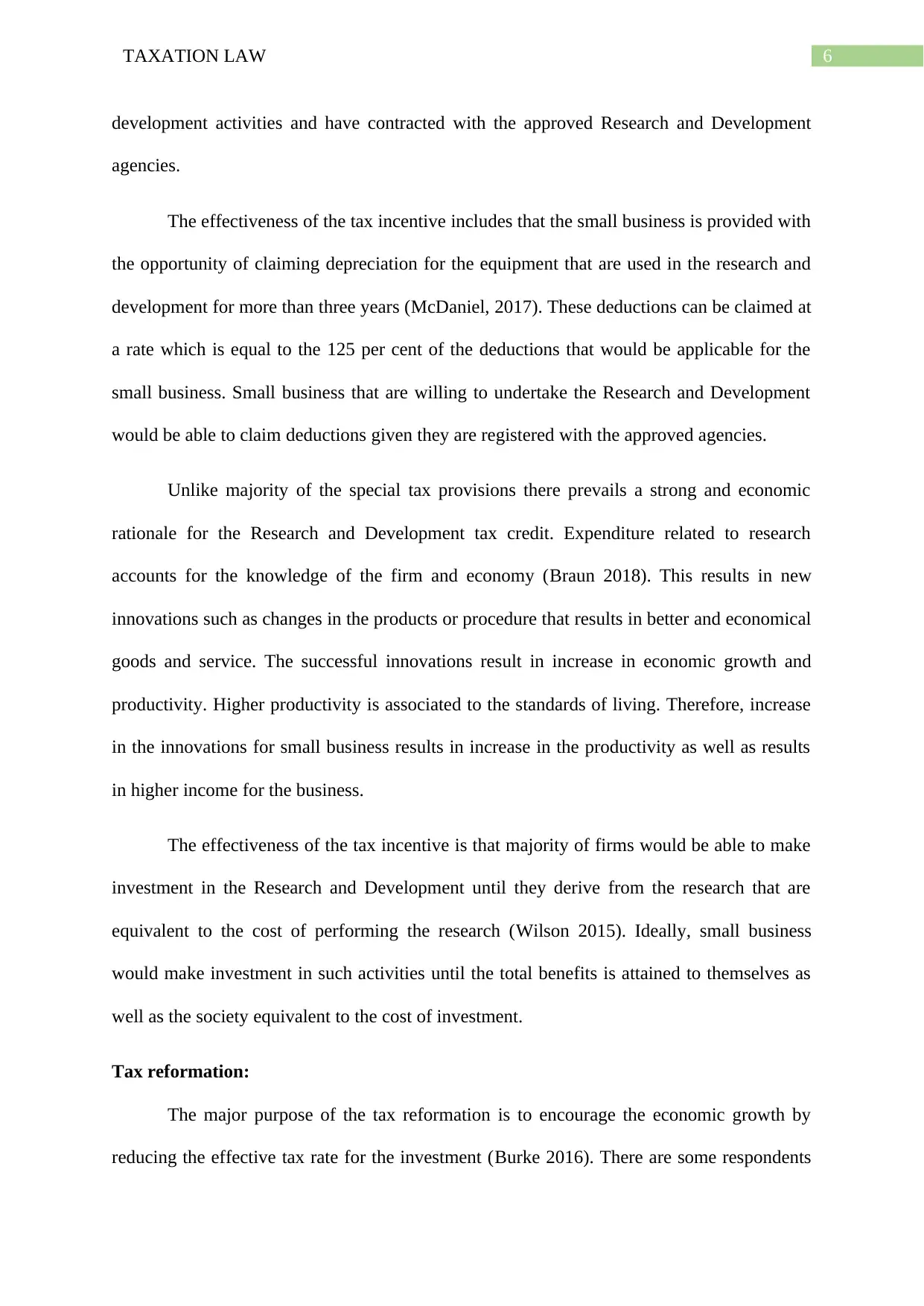
6TAXATION LAW
development activities and have contracted with the approved Research and Development
agencies.
The effectiveness of the tax incentive includes that the small business is provided with
the opportunity of claiming depreciation for the equipment that are used in the research and
development for more than three years (McDaniel, 2017). These deductions can be claimed at
a rate which is equal to the 125 per cent of the deductions that would be applicable for the
small business. Small business that are willing to undertake the Research and Development
would be able to claim deductions given they are registered with the approved agencies.
Unlike majority of the special tax provisions there prevails a strong and economic
rationale for the Research and Development tax credit. Expenditure related to research
accounts for the knowledge of the firm and economy (Braun 2018). This results in new
innovations such as changes in the products or procedure that results in better and economical
goods and service. The successful innovations result in increase in economic growth and
productivity. Higher productivity is associated to the standards of living. Therefore, increase
in the innovations for small business results in increase in the productivity as well as results
in higher income for the business.
The effectiveness of the tax incentive is that majority of firms would be able to make
investment in the Research and Development until they derive from the research that are
equivalent to the cost of performing the research (Wilson 2015). Ideally, small business
would make investment in such activities until the total benefits is attained to themselves as
well as the society equivalent to the cost of investment.
Tax reformation:
The major purpose of the tax reformation is to encourage the economic growth by
reducing the effective tax rate for the investment (Burke 2016). There are some respondents
development activities and have contracted with the approved Research and Development
agencies.
The effectiveness of the tax incentive includes that the small business is provided with
the opportunity of claiming depreciation for the equipment that are used in the research and
development for more than three years (McDaniel, 2017). These deductions can be claimed at
a rate which is equal to the 125 per cent of the deductions that would be applicable for the
small business. Small business that are willing to undertake the Research and Development
would be able to claim deductions given they are registered with the approved agencies.
Unlike majority of the special tax provisions there prevails a strong and economic
rationale for the Research and Development tax credit. Expenditure related to research
accounts for the knowledge of the firm and economy (Braun 2018). This results in new
innovations such as changes in the products or procedure that results in better and economical
goods and service. The successful innovations result in increase in economic growth and
productivity. Higher productivity is associated to the standards of living. Therefore, increase
in the innovations for small business results in increase in the productivity as well as results
in higher income for the business.
The effectiveness of the tax incentive is that majority of firms would be able to make
investment in the Research and Development until they derive from the research that are
equivalent to the cost of performing the research (Wilson 2015). Ideally, small business
would make investment in such activities until the total benefits is attained to themselves as
well as the society equivalent to the cost of investment.
Tax reformation:
The major purpose of the tax reformation is to encourage the economic growth by
reducing the effective tax rate for the investment (Burke 2016). There are some respondents
Paraphrase This Document
Need a fresh take? Get an instant paraphrase of this document with our AI Paraphraser
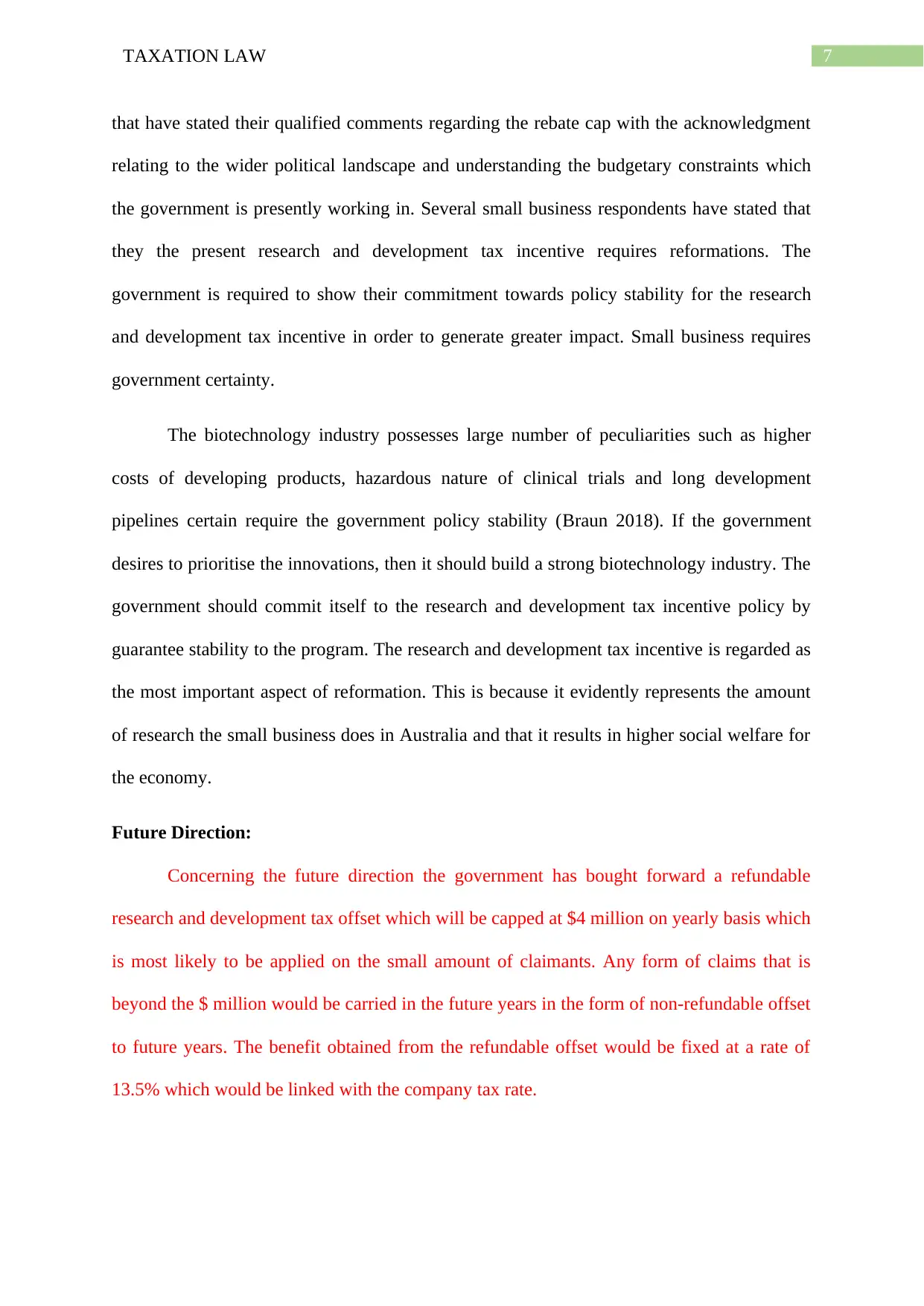
7TAXATION LAW
that have stated their qualified comments regarding the rebate cap with the acknowledgment
relating to the wider political landscape and understanding the budgetary constraints which
the government is presently working in. Several small business respondents have stated that
they the present research and development tax incentive requires reformations. The
government is required to show their commitment towards policy stability for the research
and development tax incentive in order to generate greater impact. Small business requires
government certainty.
The biotechnology industry possesses large number of peculiarities such as higher
costs of developing products, hazardous nature of clinical trials and long development
pipelines certain require the government policy stability (Braun 2018). If the government
desires to prioritise the innovations, then it should build a strong biotechnology industry. The
government should commit itself to the research and development tax incentive policy by
guarantee stability to the program. The research and development tax incentive is regarded as
the most important aspect of reformation. This is because it evidently represents the amount
of research the small business does in Australia and that it results in higher social welfare for
the economy.
Future Direction:
Concerning the future direction the government has bought forward a refundable
research and development tax offset which will be capped at $4 million on yearly basis which
is most likely to be applied on the small amount of claimants. Any form of claims that is
beyond the $ million would be carried in the future years in the form of non-refundable offset
to future years. The benefit obtained from the refundable offset would be fixed at a rate of
13.5% which would be linked with the company tax rate.
that have stated their qualified comments regarding the rebate cap with the acknowledgment
relating to the wider political landscape and understanding the budgetary constraints which
the government is presently working in. Several small business respondents have stated that
they the present research and development tax incentive requires reformations. The
government is required to show their commitment towards policy stability for the research
and development tax incentive in order to generate greater impact. Small business requires
government certainty.
The biotechnology industry possesses large number of peculiarities such as higher
costs of developing products, hazardous nature of clinical trials and long development
pipelines certain require the government policy stability (Braun 2018). If the government
desires to prioritise the innovations, then it should build a strong biotechnology industry. The
government should commit itself to the research and development tax incentive policy by
guarantee stability to the program. The research and development tax incentive is regarded as
the most important aspect of reformation. This is because it evidently represents the amount
of research the small business does in Australia and that it results in higher social welfare for
the economy.
Future Direction:
Concerning the future direction the government has bought forward a refundable
research and development tax offset which will be capped at $4 million on yearly basis which
is most likely to be applied on the small amount of claimants. Any form of claims that is
beyond the $ million would be carried in the future years in the form of non-refundable offset
to future years. The benefit obtained from the refundable offset would be fixed at a rate of
13.5% which would be linked with the company tax rate.
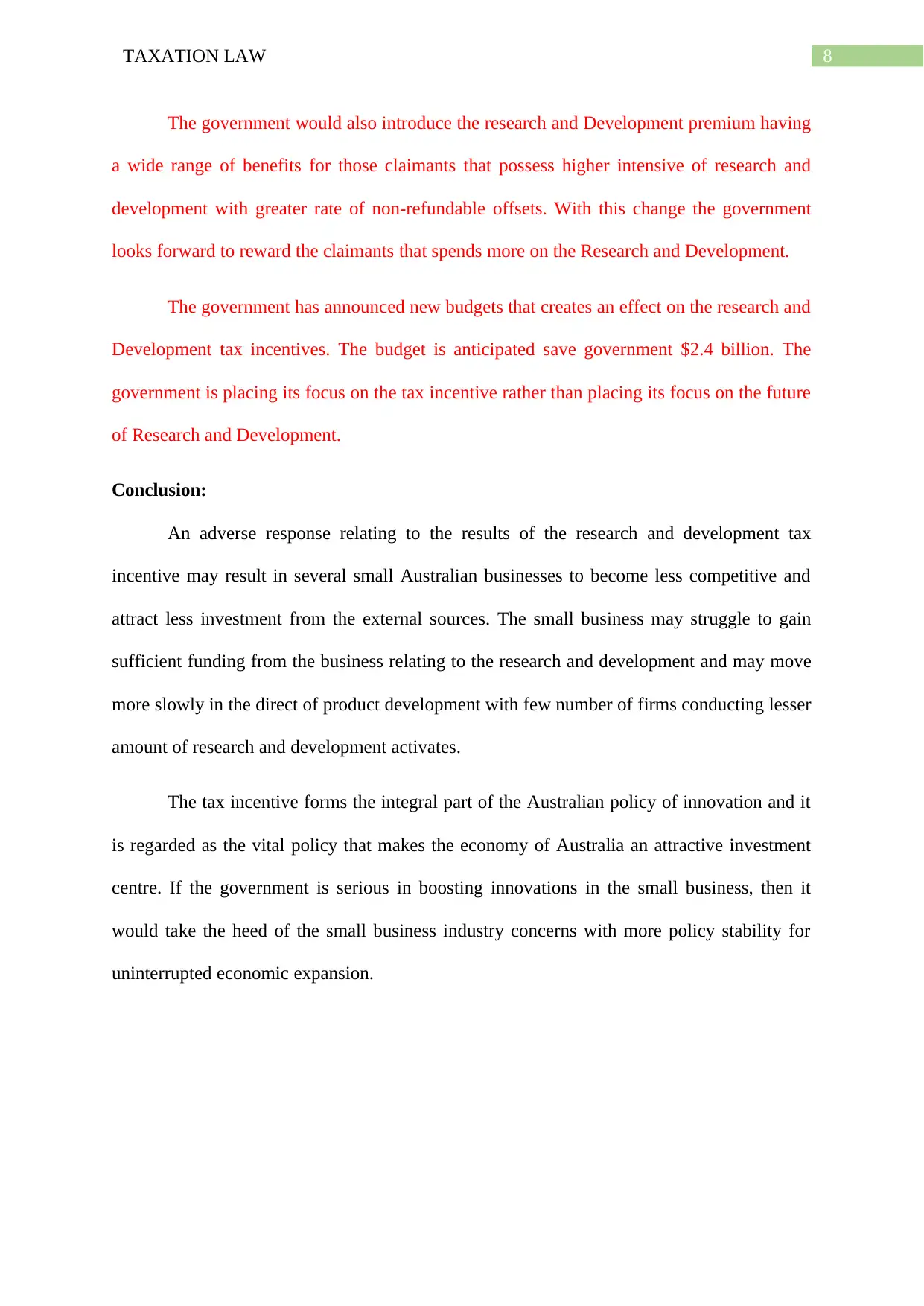
8TAXATION LAW
The government would also introduce the research and Development premium having
a wide range of benefits for those claimants that possess higher intensive of research and
development with greater rate of non-refundable offsets. With this change the government
looks forward to reward the claimants that spends more on the Research and Development.
The government has announced new budgets that creates an effect on the research and
Development tax incentives. The budget is anticipated save government $2.4 billion. The
government is placing its focus on the tax incentive rather than placing its focus on the future
of Research and Development.
Conclusion:
An adverse response relating to the results of the research and development tax
incentive may result in several small Australian businesses to become less competitive and
attract less investment from the external sources. The small business may struggle to gain
sufficient funding from the business relating to the research and development and may move
more slowly in the direct of product development with few number of firms conducting lesser
amount of research and development activates.
The tax incentive forms the integral part of the Australian policy of innovation and it
is regarded as the vital policy that makes the economy of Australia an attractive investment
centre. If the government is serious in boosting innovations in the small business, then it
would take the heed of the small business industry concerns with more policy stability for
uninterrupted economic expansion.
The government would also introduce the research and Development premium having
a wide range of benefits for those claimants that possess higher intensive of research and
development with greater rate of non-refundable offsets. With this change the government
looks forward to reward the claimants that spends more on the Research and Development.
The government has announced new budgets that creates an effect on the research and
Development tax incentives. The budget is anticipated save government $2.4 billion. The
government is placing its focus on the tax incentive rather than placing its focus on the future
of Research and Development.
Conclusion:
An adverse response relating to the results of the research and development tax
incentive may result in several small Australian businesses to become less competitive and
attract less investment from the external sources. The small business may struggle to gain
sufficient funding from the business relating to the research and development and may move
more slowly in the direct of product development with few number of firms conducting lesser
amount of research and development activates.
The tax incentive forms the integral part of the Australian policy of innovation and it
is regarded as the vital policy that makes the economy of Australia an attractive investment
centre. If the government is serious in boosting innovations in the small business, then it
would take the heed of the small business industry concerns with more policy stability for
uninterrupted economic expansion.
⊘ This is a preview!⊘
Do you want full access?
Subscribe today to unlock all pages.

Trusted by 1+ million students worldwide
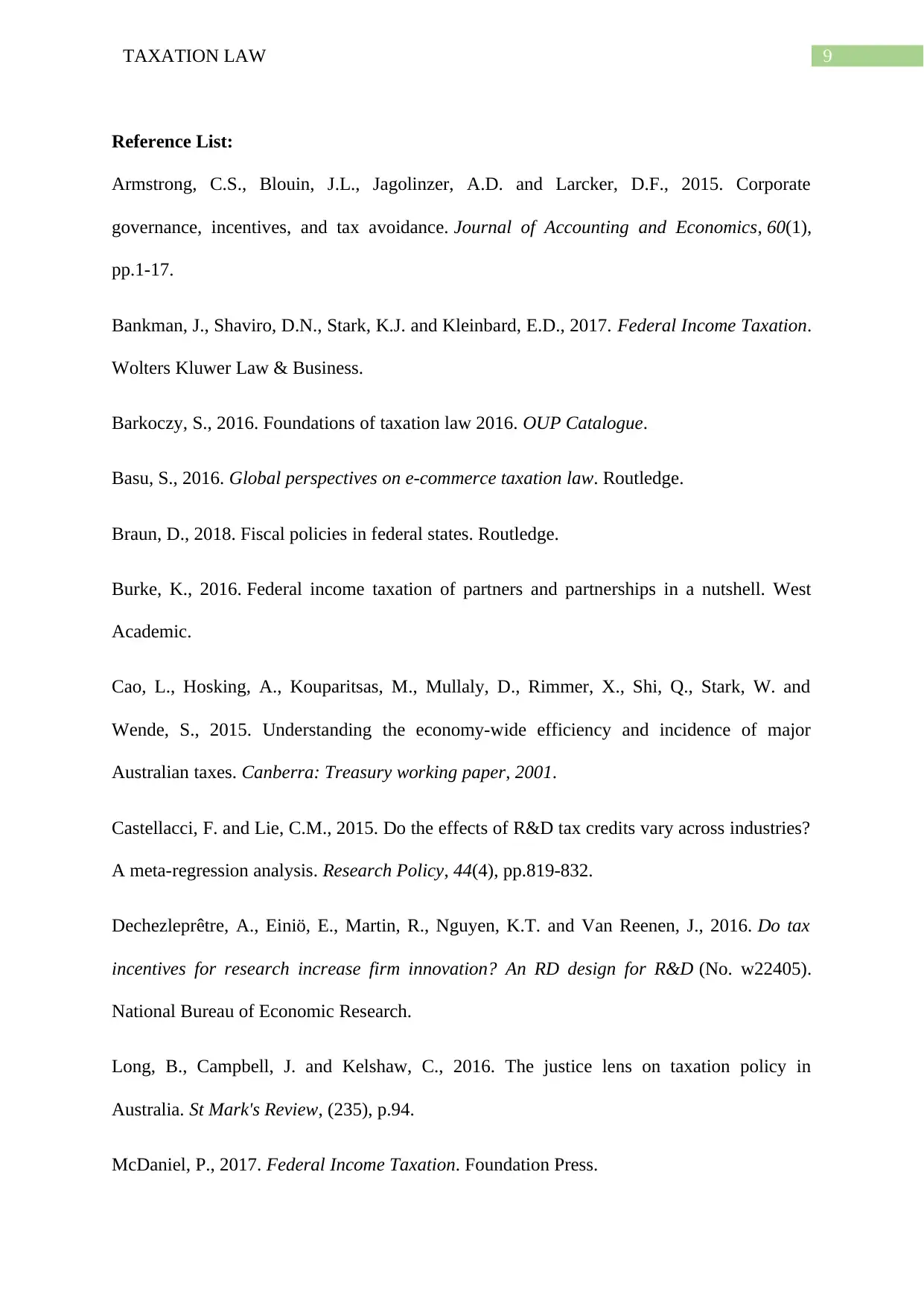
9TAXATION LAW
Reference List:
Armstrong, C.S., Blouin, J.L., Jagolinzer, A.D. and Larcker, D.F., 2015. Corporate
governance, incentives, and tax avoidance. Journal of Accounting and Economics, 60(1),
pp.1-17.
Bankman, J., Shaviro, D.N., Stark, K.J. and Kleinbard, E.D., 2017. Federal Income Taxation.
Wolters Kluwer Law & Business.
Barkoczy, S., 2016. Foundations of taxation law 2016. OUP Catalogue.
Basu, S., 2016. Global perspectives on e-commerce taxation law. Routledge.
Braun, D., 2018. Fiscal policies in federal states. Routledge.
Burke, K., 2016. Federal income taxation of partners and partnerships in a nutshell. West
Academic.
Cao, L., Hosking, A., Kouparitsas, M., Mullaly, D., Rimmer, X., Shi, Q., Stark, W. and
Wende, S., 2015. Understanding the economy-wide efficiency and incidence of major
Australian taxes. Canberra: Treasury working paper, 2001.
Castellacci, F. and Lie, C.M., 2015. Do the effects of R&D tax credits vary across industries?
A meta-regression analysis. Research Policy, 44(4), pp.819-832.
Dechezleprêtre, A., Einiö, E., Martin, R., Nguyen, K.T. and Van Reenen, J., 2016. Do tax
incentives for research increase firm innovation? An RD design for R&D (No. w22405).
National Bureau of Economic Research.
Long, B., Campbell, J. and Kelshaw, C., 2016. The justice lens on taxation policy in
Australia. St Mark's Review, (235), p.94.
McDaniel, P., 2017. Federal Income Taxation. Foundation Press.
Reference List:
Armstrong, C.S., Blouin, J.L., Jagolinzer, A.D. and Larcker, D.F., 2015. Corporate
governance, incentives, and tax avoidance. Journal of Accounting and Economics, 60(1),
pp.1-17.
Bankman, J., Shaviro, D.N., Stark, K.J. and Kleinbard, E.D., 2017. Federal Income Taxation.
Wolters Kluwer Law & Business.
Barkoczy, S., 2016. Foundations of taxation law 2016. OUP Catalogue.
Basu, S., 2016. Global perspectives on e-commerce taxation law. Routledge.
Braun, D., 2018. Fiscal policies in federal states. Routledge.
Burke, K., 2016. Federal income taxation of partners and partnerships in a nutshell. West
Academic.
Cao, L., Hosking, A., Kouparitsas, M., Mullaly, D., Rimmer, X., Shi, Q., Stark, W. and
Wende, S., 2015. Understanding the economy-wide efficiency and incidence of major
Australian taxes. Canberra: Treasury working paper, 2001.
Castellacci, F. and Lie, C.M., 2015. Do the effects of R&D tax credits vary across industries?
A meta-regression analysis. Research Policy, 44(4), pp.819-832.
Dechezleprêtre, A., Einiö, E., Martin, R., Nguyen, K.T. and Van Reenen, J., 2016. Do tax
incentives for research increase firm innovation? An RD design for R&D (No. w22405).
National Bureau of Economic Research.
Long, B., Campbell, J. and Kelshaw, C., 2016. The justice lens on taxation policy in
Australia. St Mark's Review, (235), p.94.
McDaniel, P., 2017. Federal Income Taxation. Foundation Press.
Paraphrase This Document
Need a fresh take? Get an instant paraphrase of this document with our AI Paraphraser
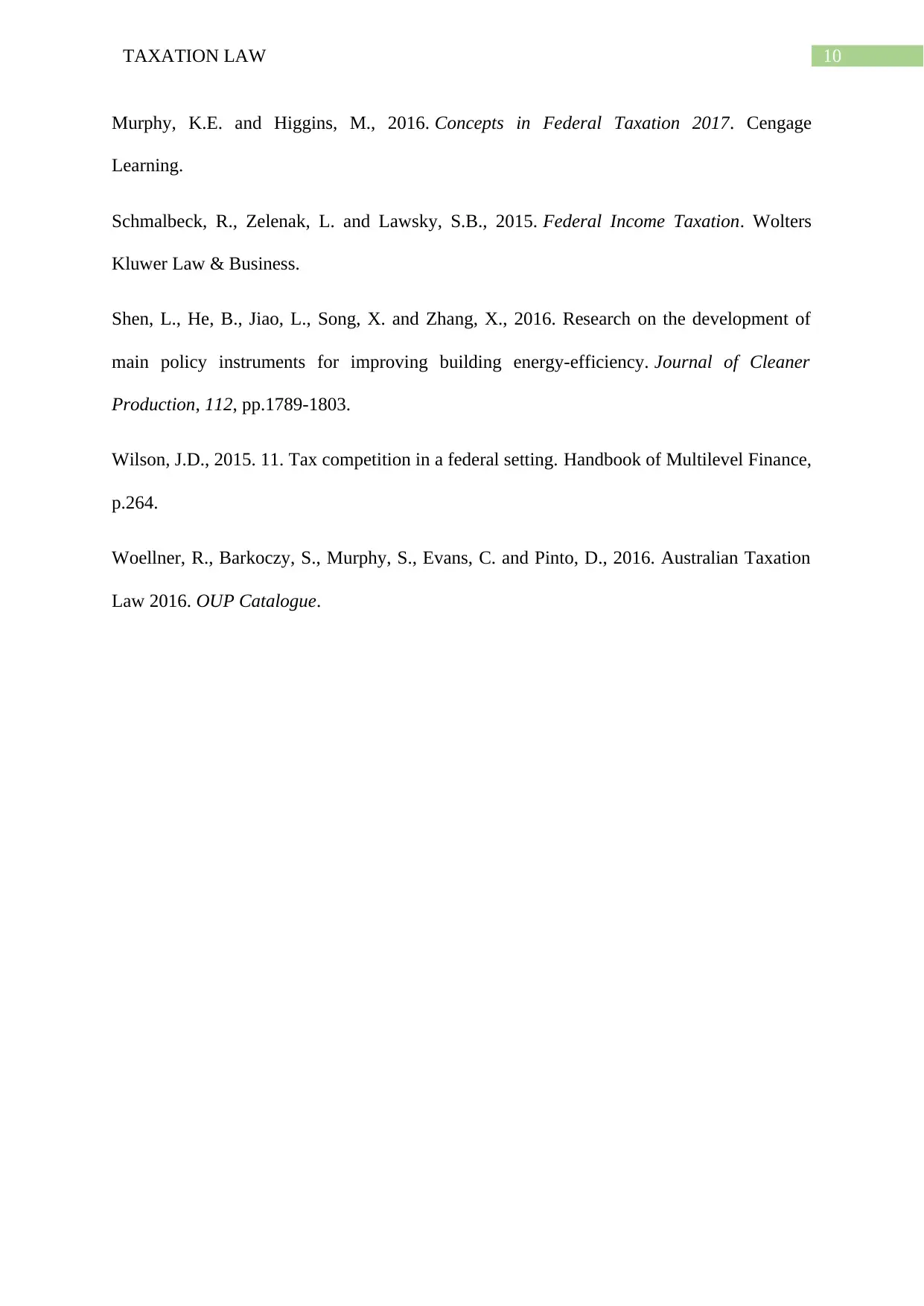
10TAXATION LAW
Murphy, K.E. and Higgins, M., 2016. Concepts in Federal Taxation 2017. Cengage
Learning.
Schmalbeck, R., Zelenak, L. and Lawsky, S.B., 2015. Federal Income Taxation. Wolters
Kluwer Law & Business.
Shen, L., He, B., Jiao, L., Song, X. and Zhang, X., 2016. Research on the development of
main policy instruments for improving building energy-efficiency. Journal of Cleaner
Production, 112, pp.1789-1803.
Wilson, J.D., 2015. 11. Tax competition in a federal setting. Handbook of Multilevel Finance,
p.264.
Woellner, R., Barkoczy, S., Murphy, S., Evans, C. and Pinto, D., 2016. Australian Taxation
Law 2016. OUP Catalogue.
Murphy, K.E. and Higgins, M., 2016. Concepts in Federal Taxation 2017. Cengage
Learning.
Schmalbeck, R., Zelenak, L. and Lawsky, S.B., 2015. Federal Income Taxation. Wolters
Kluwer Law & Business.
Shen, L., He, B., Jiao, L., Song, X. and Zhang, X., 2016. Research on the development of
main policy instruments for improving building energy-efficiency. Journal of Cleaner
Production, 112, pp.1789-1803.
Wilson, J.D., 2015. 11. Tax competition in a federal setting. Handbook of Multilevel Finance,
p.264.
Woellner, R., Barkoczy, S., Murphy, S., Evans, C. and Pinto, D., 2016. Australian Taxation
Law 2016. OUP Catalogue.
1 out of 11
Related Documents
Your All-in-One AI-Powered Toolkit for Academic Success.
+13062052269
info@desklib.com
Available 24*7 on WhatsApp / Email
![[object Object]](/_next/static/media/star-bottom.7253800d.svg)
Unlock your academic potential
Copyright © 2020–2025 A2Z Services. All Rights Reserved. Developed and managed by ZUCOL.





